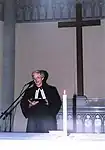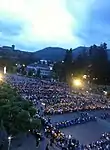.jpg.webp)

A candlelight vigil or candlelit vigil or candlelight service is an outdoor assembly of people carrying candles, held after sunset in order to pray, show support for a specific cause, or remember the dead, in which case, the event is often called a candlelight memorial.[1] Such events may be held to protest the suffering of some marginalized group of people. A large candlelight vigil may have invited speakers with a public address system and may be covered by local or national media. Speakers give their speech at the beginning of the vigil to explain why they are holding a vigil and what it represents.[2] Vigils may also have a religious purpose that contains prayer and fasting.[1] On Christmas Eve many churches hold a candlelight vigil.
Candlelight vigils are seen as a nonviolent way to raise awareness of a cause and to motivate change, as well as uniting and supporting those attending the vigil.[3]
Candlelight vigils in South Korea
In South Korea, the Candlelight vigils,[4] or Candlelight protests[5] is a symbolic collective gathering of political dissent in South Korea to combat injustice peacefully.[6] This method of protesting began in 2002 as a result of the Yangju highway incident,[7] was utilized in the rallies against the impeachment of Roh Moo-hyun in 2004, re-used again in the 2008 U.S. beef protests, and emerged in the 2016-18 President Park Geun-hye protests.[8]
Candlelight vigils in EVE Online
In the video game community of EVE Online, a "Cyno Vigil" (Cynosural Field) is held in remembrance of players who have died. The in game slang of "lighting a candle" is used when activating the Cynosural Field.
Gallery
 A pastor leads prayer in the Czech Brethren Church of John Amos Comenius for the International AIDS Candlelight Memorial (2001)
A pastor leads prayer in the Czech Brethren Church of John Amos Comenius for the International AIDS Candlelight Memorial (2001) 2010 National Police Week 22nd annual candlelight vigil at the National Law Enforcement Officers Memorial at Judiciary Square, Washington, D.C.
2010 National Police Week 22nd annual candlelight vigil at the National Law Enforcement Officers Memorial at Judiciary Square, Washington, D.C. Candlelight vigil at the Katyń Memorial Cross at the Church of St. Giles, Kraków following the Smolensk air disaster
Candlelight vigil at the Katyń Memorial Cross at the Church of St. Giles, Kraków following the Smolensk air disaster
 Candlelight service at Andrews Memorial Chapel at Westminster School (Connecticut)
Candlelight service at Andrews Memorial Chapel at Westminster School (Connecticut) Every year from 1990 to 2019, people attend candlelight vigils on June 4 in Victoria Park, Hong Kong commemorating the victims of 1989 Tiananmen Square protests. It could no longer be held.
Every year from 1990 to 2019, people attend candlelight vigils on June 4 in Victoria Park, Hong Kong commemorating the victims of 1989 Tiananmen Square protests. It could no longer be held. A candlelight vigil in Lourdes, France.
A candlelight vigil in Lourdes, France.
See also
References
- 1 2 Shields, Bruce E.; Butzu, David Alan (2007). Generations of Praise: The History of Worship. College Press. p. 244. ISBN 978-0-89900-941-4.
- ↑ "Do Something: how to organise a vigil". Retrieved 28 December 2012.
- ↑ "love to know: Organise a candlelight vigil". Retrieved 28 December 2012.
- ↑ Cho, Elliot (13 December 2016). "South Korea's 'Candlelight Revolution' Matters". Huffington Post. Retrieved 14 March 2019.
- ↑ Kim, Yong-cheol; Kim, June-woo (2009). "South Korean Democracy in the Digital Age: The Candlelight Protests and the Internet". 40 (1): 53–85. ProQuest 209355027.
{{cite journal}}: Cite journal requires|journal=(help) - ↑ Premack, Rachel (2 December 2016). "Koreans Have Mastered the Art of the Protest". Foreign Policy. Retrieved 9 March 2019.
- ↑ Shinn, Henry (4 April 2010). "Deja vu? Candlelight vigils in 2002 and present". The Korea Herald. Retrieved 14 March 2019.
- ↑ "South Korea: thousands of protesters call for president to resign". The Guardian. 29 October 2016. Retrieved 14 March 2019.